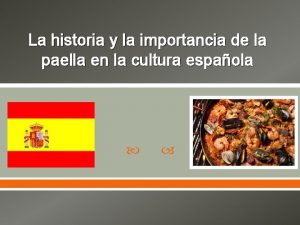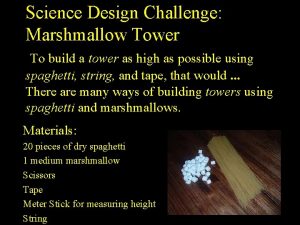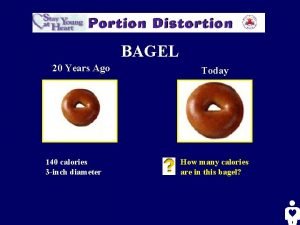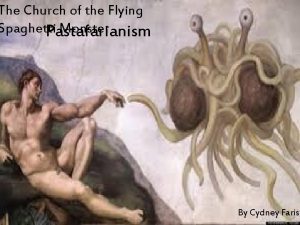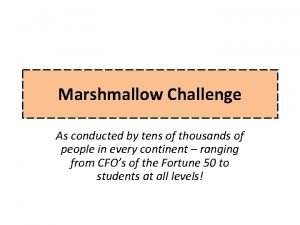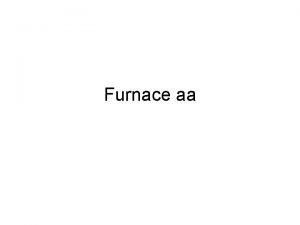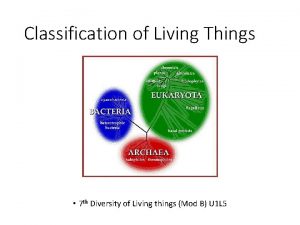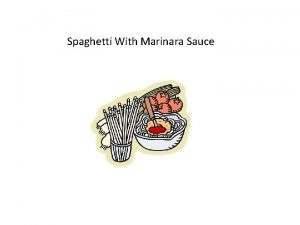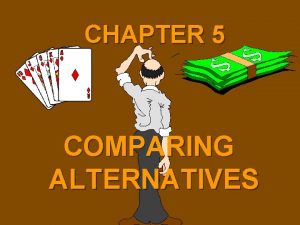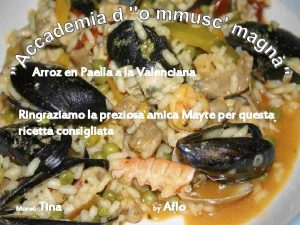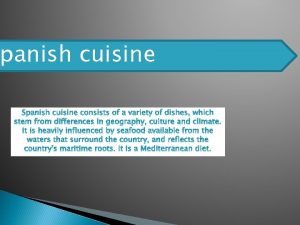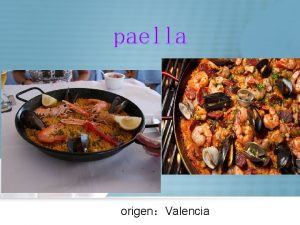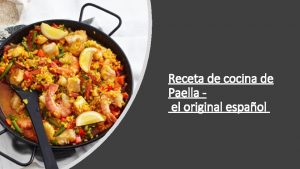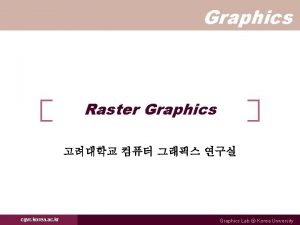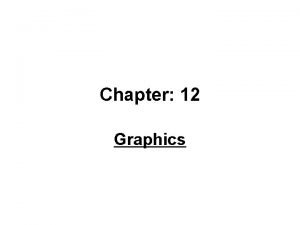Spaghetti paella and alternatives Graphics for multiple series









































![fabplot syntax fabplot command yvar xvar [if] [in] , by(byvar [, byopts]) [ front(twoway_command) fabplot syntax fabplot command yvar xvar [if] [in] , by(byvar [, byopts]) [ front(twoway_command)](https://slidetodoc.com/presentation_image_h2/73ef3ee3fb19da135a078af69552ae39/image-42.jpg)





- Slides: 47

Spaghetti, paella and alternatives: Graphics for multiple series and groups Nicholas J. Cox Department of Geography 1

Spaghetti is a tangle Spaghetti plots show many tangled lines – say for multiple time series or other functional traces – which can be hard to distinguish and interpret. We may see broad collective patterns, but can we tell apart fine structure and mere noise? 2

pasta Stata 3

Paella is problematic Paella plots show multiple point patterns for many groups, sufficiently mixed up that comparisons are made difficult. 4

appealing? appalling? 5

This talk surveys several strategies and tactics for better, friendlier comparisons. Devices range from showing data several times over to selection, smoothing and transformation. Headline for those marginally interested: the least standard and possibly most interesting idea here is what are now called front-and-back plots. 6

Superimpose? Wood for trees… 7

Arctic sea ice extent Seasonality is clear: ice melts in summer, freezes in winter Trend is not so clear from this graph Source: ftp: //sidads. colorado. edu/DATASETS/NOAA/G 02135/nor th/monthly/data 8

One graph to summarize 9

Juxtapose? Trees within the wood… 10

Superimpose? 11

Grunfeld data One version of several is bundled with Stata: webuse grunfeld Named for Yehuda Grunfeld (1930– 1960) Kleiber, C. and Zeileis, A. 2010. The Grunfeld Data at 50. German Economic Review 11: 404 -417. doi: 10. 1111/j. 1468 -0475. 2010. 00513. x 12

Juxtapose? 13

Generic grumbles The previous two graphs came from easy commands: xtline invest, overlay xtline invest Necessarily the results of default choices are often poor – even with a few panels and few observations in each. At best, xtline and tsline are starting points. 14

Transform the response! Here logarithms 15

16

Other transformations neglog = sign(x) * log(1 + abs(x)) are like logarithms, but for zero and negative values too Stata 15. 1 updated 7 August 2018 plus: easier using sign(x) * log 1 p(abs(x)) inverse hyperbolic sine asinh() square or cube roots reciprocals logits 17

Tiny tips + Lose the default note() with by(): usually groups are best explained outside the graph. + Lose default xtitle()s that are merely year, date or the like: your readers don’t need them! + Stata’s defaults for logarithmic axis labels are often lousy, but for discussion and help see 2018. Logarithmic binning and labeling. Stata Journal 18: 262– 286 http: //www. stata-journal. com/article. html? article=gr 0072 18

Prominent problems Do these graphs really work well? Again, this is the easy end of plotting panel data: there are only 10 panels in the Grunfeld data. Improvements on various levels: + Lose the legend! Kill the key! It grabs too much space. + Two or three colours are great, but not ten or twelve. + Front-and-back plots! 19

Lose the legend: Explanatory marker labels? Suppress the marker symbol and put an identifier in a marker label in its place. This works for small integers, US states (MA, TX), ISO country codes (DE, FR), etc. It can work best if you care mostly about extremes. 20

Lose the legend: trailing text labels? Add marker labels as scatter plot elements at the ends of the series. The default marker label position of 3 o’clock is exactly right. This can be elaborated with starting text labels as well and/or different groups with matched line and marker label colours. 21

Colours are not so crucial If we explain each series otherwise – with self-explanatory labels or trailing text labels – we can often dispense with the “fruit salad” or “technicolour dreamcoat” effects. Never use red and green together: use red or orange and blue. 22

23

Front-and-back plots New name (14 June 2018) for a slightly old idea! https: //www. statalist. org/forums/forum/general-statadiscussion/general/270264 -subsetplot-available-onssc/page 2 The current Stata implementation is fabplot (SSC). Read that alternatively as “foreground and backdrop”. Names should not matter, but they do. If now fabplot, can groovyplot be far behind? 24

The main idea Superimpose and juxtapose! Show each group in turn with the others as backdrop. Contrast line width and line colour (or marker properties). The Stata machinery The major trick lies in temporary restructuring of the data. twoway, by() is used to do the hard graphics work. 25

Going grey is good! 2009. Going gray gracefully: Highlighting subsets and downplaying substrates. Stata Journal 9: 499– 503 https: //www. statajournal. com/sjpdf. html? articlenum=gr 0040 The spelling of this colo[u]r can change mid-Atlantic. 26

Some references on front-and-back plots I Wallgren, A. , B. Wallgren, R. Persson, U. Jorner, and J. -A. Haaland. 1996. Graphing Statistics and Data: Creating Better Charts. Newbury Park, CA: Sage. Koenker, R. 2005. Quantile Regression. Cambridge: Cambridge University Press. See pp. 12– 13. Carr, D. B. and L. W. Pickle. 2010. Visualizing Data Patterns with Micromaps. Boca Raton, FL: CRC Press. p. 85. Cox, N. J. 2010. Graphing subsets. Stata Journal 10: 670– 681. Rougier, N. P. , Droettboom, M. and Bourne, P. E. 2014. Ten simple rules for better figures. PLOS Computational Biology 10(9): e 1003833. Schwabish, J. A. 2014. An economist's guide to visualizing data. Journal of Economic Perspectives 28: 209– 234. 27

Some references on front-and-back plots II Knaflic, C. N. 2015. Storytelling with Data: A Data Visualization Guide for Business Professionals. Hoboken, NJ: Wiley. Unwin, A. 2015. Graphical Data Analysis with R. Boca Raton, FL: CRC Press. Cairo, A. 2016. The Truthful Art: Data, Charts, and Maps for Communication. San Francisco, CA: New Riders. p. 211 Camões, J. 2016. Data at Work: Best Practices for Creating Effective Charts and Information Graphics in Microsoft Excel. San Francisco, CA: New Riders. See p. 354 Wickham, H. 2016. ggplot 2: Elegant Graphics for Data Analysis. Cham: Springer. See p. 157. Schwabish, J. 2017. Better Presentations: A Guide for Scholars, Researchers, and Wonks. New York: Columbia University Press. See p. 98. 28

If you know other references, please let the author know. 29

More strategies: we will see some…. Select. Don’t try to show everything. Focus on what is of greatest interest or importance. Smooth. Remove minor fluctuations that are likely to be just noise. Subtract. Remove summaries or model fits and show residuals to see what is idiosyncratic. Subdivide. Subsets or groups can identified helpfully. 30

31

New York Choral Society 1979 Data used in 2007. Turning over a new leaf. Stata Journal 7: 413– 433, which in turn gives references. https: //www. statajournal. com/sjpdf. html? articlenum=gr 0028 Quantile plots show ordered values for each singer part against plotting position, so (e. g. ) 0. 25, 0. 75 would be plotting positions for lower quartile, median, upper quartile. Measurements are given in inches. We add a metric axis. 32

33

Quantiles can be smoothed An appropriate smoothing comes from Harrell, F. E. and C. E. Davis. 1982. A new distribution-free quantile estimator. Biometrika 69: 635– 640. There is a Stata implementation in hdquantile (SSC). These quantile plots are both obtained using fabplot. 34

35

Select! 2 × 2, 3 × 3, 4 × 4 and other displays can look good. 36

37

Subtract summaries The recipe here – one of many possible – is + Interpolate a few gaps using piecewise cubic Hermite method (mipolate, SSC). + Calculate mean and SD over months for reference period 1981– 2010. + Show selected recent years in standard scores defined by those means and SDs. Evidently, the more general idea is to look at residuals from any model or summary of interest. 38

auto data It would be remiss to ignore the auto data bundled with Stata. 39

40

41
![fabplot syntax fabplot command yvar xvar if in bybyvar byopts fronttwowaycommand fabplot syntax fabplot command yvar xvar [if] [in] , by(byvar [, byopts]) [ front(twoway_command)](https://slidetodoc.com/presentation_image_h2/73ef3ee3fb19da135a078af69552ae39/image-42.jpg)
fabplot syntax fabplot command yvar xvar [if] [in] , by(byvar [, byopts]) [ front(twoway_command) frontopts(twoway_options) graph_options ] where command can be scatter, line, connected, etc. 42

Words from the wise? Stephen M. Kosslyn To communicate effectively, your display should be understood at a glance and later recalled without effort. (2006. Graph Design for the Eye and Mind, p. 14) For an incisive review, see https: //www. amazon. com/review/RVIIR 7 L 4 RMN 25 43

Words from the wise? William S. Cleveland Many useful graphs require careful, detailed study. (1994. The Elements of Graphing Data, p. 115) 44

Words from the wise The purpose of computing is insight, not numbers. Richard Wesley Hamming (1915– 1998) The purpose of computing is insight, not pictures. Lloyd Nicholas Trefethen (1955–) 45

46

All graphs use Stata scheme s 1 color, which I strongly recommend as a lazy but good default. This font is Georgia. This font is Lucida Console. 47
 Alliteration poem
Alliteration poem Smarty smarty had a party poem
Smarty smarty had a party poem How to make spaghetti
How to make spaghetti Spaghetti spaghetti you're wonderful stuff
Spaghetti spaghetti you're wonderful stuff Types of paella
Types of paella Historia de la paella
Historia de la paella Paella malzemeleri
Paella malzemeleri Most of the graphics monitors today operate as
Most of the graphics monitors today operate as Marshmallow challenge record height
Marshmallow challenge record height Lcd working principle ppt
Lcd working principle ppt Series aiding and series opposing
Series aiding and series opposing Spaghetti detector
Spaghetti detector Contoh proposal usaha makanan internasional spaghetti
Contoh proposal usaha makanan internasional spaghetti Time to cook spaghetti
Time to cook spaghetti The wormy spaghetti the twits
The wormy spaghetti the twits Stata lgraph
Stata lgraph How many calories are in today’s portion of soda?
How many calories are in today’s portion of soda? Adriaan van dis een bord met spaghetti
Adriaan van dis een bord met spaghetti Pastafarian holidays
Pastafarian holidays Diagram spaghetti
Diagram spaghetti Best spaghetti marshmallow structure
Best spaghetti marshmallow structure Spaghetti plot spss
Spaghetti plot spss Do you like spaghetti
Do you like spaghetti Cual es la notacion de lewis para el atomo representado por
Cual es la notacion de lewis para el atomo representado por Spaghetti technique
Spaghetti technique King phillip came over for good spaghetti
King phillip came over for good spaghetti Dear king phillip came over
Dear king phillip came over 10 market forms of poultry
10 market forms of poultry Spaghetti bowl comercio
Spaghetti bowl comercio Melatonina life 120 dosaggio
Melatonina life 120 dosaggio Baseline
Baseline Multiple instruction multiple data
Multiple instruction multiple data A series of coordinated related multiple projects
A series of coordinated related multiple projects A series of coordinated related multiple projects
A series of coordinated related multiple projects Modern project management
Modern project management A series of coordinated related multiple projects
A series of coordinated related multiple projects A series of coordinated related multiple projects
A series of coordinated related multiple projects A series of coordinated related multiple projects
A series of coordinated related multiple projects Maclaurin series vs taylor series
Maclaurin series vs taylor series Heisenberg 1925 paper
Heisenberg 1925 paper Maclaurin expansion
Maclaurin expansion Taylor series lesson
Taylor series lesson P series server
P series server The amplifier
The amplifier Arithmetic series formula
Arithmetic series formula Kontinuitetshantering
Kontinuitetshantering Typiska novell drag
Typiska novell drag Nationell inriktning för artificiell intelligens
Nationell inriktning för artificiell intelligens





